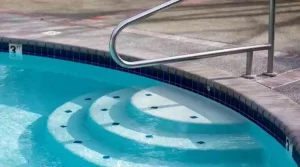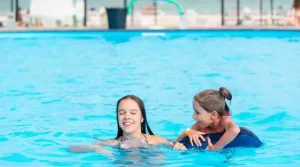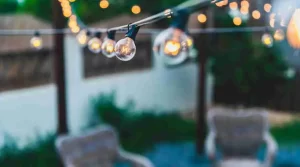It can be harder than it seems to plan your dream pool. Before you start building your inground pool, you should think about your options and what you have to do.
Few things in a home can be as fun and exciting as a swimming pool that is built into the ground. A pool can instantly turn a boring backyard into a sunny oasis that people of all ages can enjoy. Even though in-ground pools take a lot of time and money to build, their popularity isn’t going away any time soon. The Pool and Hot Tub Alliance say that there are more than 5 million in-ground pools in the United States and that nearly 200,000 new pools are built every year.
So, if you’re ready to take the plunge, so to speak, and get an in-ground swimming pool, here are six important steps to make sure you get the best pool for your home and family.
Pool Designs
In-ground pools come in three main styles. Concrete, vinyl-lined, and fiberglass are in order of how popular they are. Small parts of the country might also have pools with steel or aluminum walls.
Concrete pools are really made to order, and they can be almost any size, shape, or depth. People often call these pools “Gunite” or “Shotcrete” pools because concrete is shot with a gun onto walls that are made of steel. Once the concrete has hardened, the pool is plastered, painted, and given a textured surface or tiles to finish.
Concrete pools take the longest to build—usually between 3 and 12 weeks—but they last the longest and are the strongest. In fact, many concrete pools that are more than 50 years old are still in use today. And unlike other types of in-ground pools, concrete pools can be remodeled, enlarged, and updated.
Vinyl pools are made with a flexible liner that is already made and fits into the hole. It is attached to a strong frame made of steel, aluminum, or a polymer that doesn’t rust. Most vinyl pools are rectangular, but some manufacturers make liners that are L-shaped or have no shape at all. Most vinyl-lined pools take between one and three weeks to put together.
If you’re thinking about getting a vinyl pool, you should know that pool toys, pets, and sharp objects can all poke holes in the liner. Even though liners can be fixed, it’s best to choose one that’s at least 20 to 30 mm (about 3/4 to 1 in.) thick.
Fiberglass pools are made in a factory to look like one big bowl. A crane puts the bowl into the hole that was dug. Because of this, fiberglass pools can be put in much faster than other kinds. In some situations, as few as three days. Fiberglass pools have a smooth gel coat finish that is very strong and won’t stain. And fiberglass pools aren’t porous like concrete pools are, so they use fewer pool chemicals and have fewer algae.
But fiberglass pools don’t come in as many sizes and shapes as concrete or vinyl pools, which could be a problem if your backyard is small or has an unusual shape. And the big, pre-made pool has to be sent by truck, which may have to take a long, winding route to get to your house. That’s because each state has rules about how to move oversized loads, and truckers often have to drive through more than one state to deliver a fiberglass pool.
And when the pool arrives, there needs to be enough room in your yard for the crane to get close enough to move the shaped shell into the hole you dug. Keep in mind that sometimes you can only get there by going through a neighbor’s property. Make sure to ask the trucking company or pool contractor if the crane will have enough room to work.
Concrete, vinyl, and fiberglass pools are all available all over the country. But in some places, there are more of some kinds than of others. Because fiberglass and vinyl liners are flexible, they work well in cold places where freezing and thawing can damage a hard concrete structure. Most places sell vinyl pools, but most people in the south buy fiberglass pools.
If you’re not sure what kind of pool to get, ask a local pool contractor for help. If they mostly build one kind of pool, there’s probably a good reason for it. (It often depends on the weather and soil in the area.) And once you know what kind of pool you want, make sure to hire a contractor who has a lot of experience putting in that kind.
Cost Comparisons
It’s hard to say exactly how much your pool will cost because prices vary a lot depending on where you live, the type and size of the pool, and the soil conditions. The time of year can also affect the final price since many contractors offer discounts for pools they build when business is slow.
Concrete pools are usually the most expensive, then vinyl-lined pools, and then fiberglass pools. But a high-end fiberglass pool with all the bells and whistles could cost more than a simple concrete pool.
I can tell you that a simple rectangular 20-by-40-foot concrete pool costs about $45,000 where I live in New England. This includes the filtration system, the first water fill-up, underwater lights, and stone coping around the pool’s edge. It doesn’t include the cost of fencing, landscaping, decking, or other things that go with a pool. And remember that most people spend about twice as much on their swimming pool project as the pool costs. So, if you buy a pool for $50,000, you should expect to spend an extra $40,000 to $50,000 before everything is done.
Zoning Rules
Building and zoning rules apply to in-ground pools, so you need to apply for a building permit and get approval before you can start work.
Building and zoning rules vary from town to town, but you usually have to keep a certain distance between your pool and your property lines, wells, septic tanks, sewer lines, and wetlands. There are also rules about pool fences and the hardware on gates.
In general, a perimeter wall or fence must be at least 4 feet high and have gates that close and lock themselves. The space between fence boards or rails can’t be more than 4 inches. The gaps in chain-link fences can’t be wider than 1-1/4 inches.
For extra safety, especially if you have young children or grandchildren, you might want to install alarms on all doors and gates that lead to the pool and put a power safety cover over the pool. Contact the building department or zoning board in your area to get a list of specific rules and restrictions.
How to Choose the Right Site
As important as the pool itself is the location you choose for it. An experienced pool builder can give you good advice, but you should also think about the following when deciding where to put your pool:
- Capture the Sun: Use the sun’s free energy by putting your pool in a spot that gets a lot of suns and isn’t near any trees. Not only will this warm up the water, but it will also cut down on how many leaves fall into the pool.
- Block Breezes: If you build a pool in a windy place, a lot of the water will evaporate, so you’ll have to keep adding water to keep it at the right level. When you’re wet, strong winds can also make you feel too cold. Put up a solid-board fence or plant a row of thick shrubs to block the wind.
- High and dry: Don’t put the pool in a low-lying area, because it could fill up with mud and other things when it rains hard.
- All Clear Above and Below: The pool shouldn’t be built directly over buried sewer lines, septic systems, electrical cables, or telephone lines. It also shouldn’t be built under overhead telephones or power lines.
- Keep Eye Contact: If you can, build the pool so that it can be seen from the house. So, you can keep an eye on people swimming even when you are inside.
Circulation System
A pool’s circulation system uses both filtration and sanitization to keep the water clean and clear. The filtration pump pulls water from the pool’s bottom drains, sends the surface water through an automatic skimmer, and then puts everything through a filter before sending it back into the pool. Sand, cartridge, and diatomaceous earth are the three most common types of filters (DE).
When properly installed and cared for, all three types of filters work well, and an experienced contractor can help you decide which one is best for your pool.
Sand filters are the most common and oldest way to clean pool water. They use a special kind of sand to filter out dirt and other things. As the sand particles “load up,” or get stuck together, they catch smaller and smaller particles. Backwashing cleans sand filters. This is done by turning the water flow around and flushing the dirty water into a waste line.
Filters with cartridges use big, cylindrical cartridges to keep dirt out. Most pool builders suggest using cartridges with 500 to 600 sq. ft. of filter area. Cartridge filters don’t need to be backwashed as sand filters do. Instead, you just use a garden hose to rinse them off. This uses much less water than backwashing.
Diatomaceous earth is a powder that is porous and has tiny holes in it, like tiny sponges. Particles are caught as water flows through the holes. Dirt, dust, algae, and some kinds of bacteria can be filtered out by DE filters. Backwashing cleans DE filters when they get dirty, but it uses much less water than sand filters. Then, DE has added to the filter again.
The water filtration system in the pool gets rid of dirt and debris, but a chemical sanitizer is needed to kill bacteria and algae. An oxidizer is used to kill both inorganic and organic contaminants. There are three disinfectants that the EPA has approved for use in swimming pools. These are chlorine, bromine, and PHMB.
By far, chlorine is the most common way to clean a pool, and it also works well as an oxidizer. When chlorine is mixed with water, it releases free chlorine, also called hypochlorous acid. There are different kinds of chlorine sanitizers, such as cal hypo, dichlor, gaseous chlorine, liquid chlorine, lithium hypochlorite, and trichlor.
Tablets of bromine (hypobromous acid) can also be used to clean a pool. Bromine, which is also a strong oxidizer, is made when the solid white tablets slowly break down.
Polyhexamethylene biguanide, or PHMB, is a cleaner for swimming pools that is used with hydrogen peroxide and an algaecide. As an oxidizer, hydrogen peroxide is used.
Salt chlorine generators are the most recent improvement in cleaning pools. This system turns regular table salt into chlorine instead of using pool chlorine. In spite of what you might have heard, salt chlorine generators do not turn swimming pools into saltwater pools.
Remember that you should test the water in the pool before adding any chemicals. Take a water sample to a pool store near you to have it tested, or buy a test kit to do it yourself. Keep the alkalinity between 80 and 120 parts per million and the pH between 7.2 and 7.8. And when it’s hot for a long time, make sure to test the water several times a week to keep the right balance.
Watch out for "budget-busters"
As was already said, the total cost of an in-ground pool is usually about twice what the pool itself costs. That’s because an in-ground pool is so much more than just a hole filled with water.
Here are some things that usually aren’t included in the price of a pool: outdoor lighting, landscaping, pathways, decks, fencing, patios, privacy screens, whirlpool spas, outdoor sound system, pool cover, water test kits, shade structure, patio furniture, equipment shed, storage cabinet, pool toys, and extra outdoor electrical outlets.
Now, you probably won’t need all of these things, but keep them in mind when making a budget for the building.







